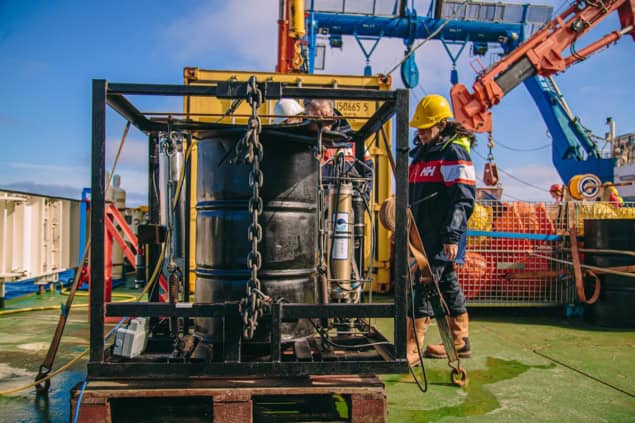Seawater located more than 2 km below the ocean’s surface drives the oceanic circulation that helps regulate the Earth’s climate. At these depths, turbulent mixing drives water towards the surface in a process called upwelling. How quickly this upwelling happens dictates how carbon and heat from the ocean are exchanged with the atmosphere.
It has been difficult to directly test how carbon storage in the ocean is controlled by deep-sea mixing processes. But with the help of a non-toxic fluorescein dye, a research team headed up at UC San Diego’s Scripps Institution of Oceanography has now directly measured cold, deep-water upwelling along the slope of a submarine canyon in the Atlantic Ocean.
Oceanic circulation a key phenomenon
The Earth relies on large-scale ocean circulation – known as conveyor belt circulation – to maintain balance. In this process, seawater becomes cold and dense near the poles and sinks into deep oceans, eventually rising back up elsewhere and becoming warm again. The cycle is then repeated. This natural mechanism helps to maintain a regular turnover of heat, nutrients and carbon, which underpins marine ecosystems and the natural ability to mitigate human-driven climate change. However, the return of cold water from the deep ocean to the surface via upwelling has been difficult to measure.
Back in the 1960s, oceanographer Walter Munk predicted that the average speed of upwelling was 1 cm/day. But while upwelling at this speed would transport large volumes of water, directly measuring this rate across entire oceans is not feasible. Munk also suggested that upwelling was caused by turbulent mixing from internal waves breaking under the ocean’s surface; but more modern-day measurements have shown that turbulence is the highest near the seafloor.
This created a paradox: if turbulence is highest at the seafloor, it would push cold water down instead of up, making the bottom waters colder and denser. But it has been confirmed in the field that the deep ocean is not completely filled with cold and dense water from the poles.
Direct evidence of diapycnal upwelling
In the last few years, a new theory has surfaced. Namely, that it is the steep slopes on the ocean’s seafloor (such as the walls of underwater canyons) that are responsible for the turbulent mixing that causes upwelling, because they provide the right type of turbulence to move water upwards.

To investigate this theory, first author Bethan Wynne-Cattanach and colleagues used a fluorescein dye to investigate the upwelling across isopycnals (layers of constant density). The research was conducted off the coast of Ireland at a 2000 m-deep canyon in the Rockall Trough.
The researchers released over 200 l of fluorescein dye at 10 m above the canyon floor, which had a local temperature of 3.53 °C. They used a fastCTD (FCTD) rapid profiler housing a fluorometer (with resolution down to the parts per billion range) to investigate how the dye moved at depths as low as 2200 m. The FCTD also carried a micro-conductivity probe to assess the dissipation rate of temperature variance – a key metric for determining turbulent mixing.
The team tracked the dye for 2.5 days. During this time, the dye’s movements showed a turbulence-driven bottom-focused diapycnal (across the isopycnals) upwelling along the slope of the canyon. They found that the flow was much faster than the original estimates, with measurements showing that the upwelling occurred at a rate of around 100 m per day. The researchers note that this first direct measurement of upwelling and its rapid speed, combined with measurements of downwelling in other parts of the oceans, suggests that there are upwelling hotspots.
The overarching conclusion of the study is that mixing of ocean waters at topographic features – such as canyons – leads to a globally significant upwelling, and that upwelling within canyons could have a more significant role in overturning deep water than previously thought. Given the numbers of submarine canyons across the globe, it’s also thought that previous global scaling based on weaker upwelling velocities could be underestimated.
This research is published in Nature.
The post Fluorescent dye helps reveal the secrets of ocean circulation appeared first on Physics World.

